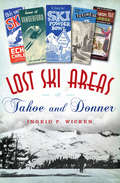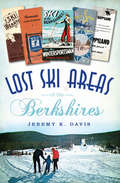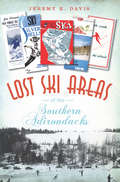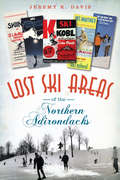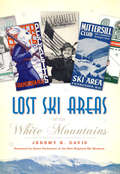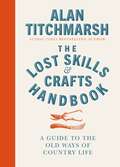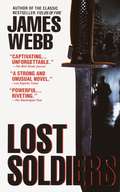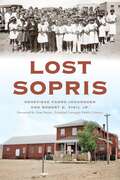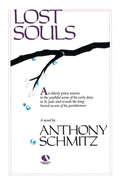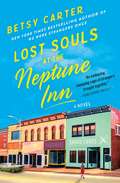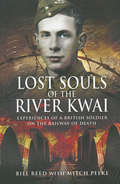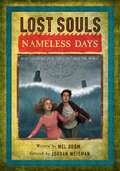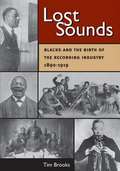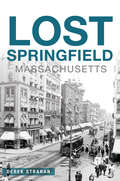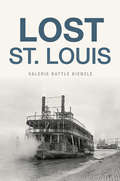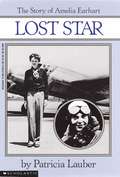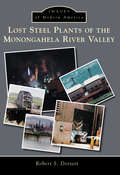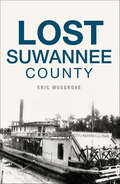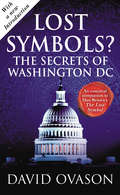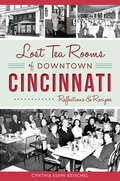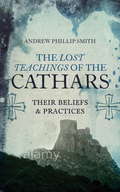- Table View
- List View
Lost Ski Areas of Tahoe and Donner
by Ingrid P. WickenAt the beginning of the twentieth century, Lake Tahoe and the Donner Summit region became California's first developed winter sports areas. Plentiful snowfall and newly built highways opened up the summer playground for visitors year-round, and skiing flourished. The Sierra Ski Club formed in 1925, attracting members eager to experience everything the mountains had to offer. People flocked to the slopes, visiting places like Clair Tappaan Lodge in Soda Springs, boasting one of the summit's earliest ski tows, and the Yuba Gap Lodge, a pioneer in night skiing. Join Ingrid P. Wicken, award-winning author and ski historian, as she recounts the fascinating beginnings of this celebrated ski hub.
Lost Ski Areas of the Berkshires (Lost)
by Jeremy K. DavisThe Berkshires of Massachusetts have long been known as a winter sports paradise. Forty-four ski areas arose from the 1930s to the 1970s. The Thunderbolt Ski Trail put the Berkshires on the map for challenging terrain. Major ski resorts like Brodie Mountain sparked the popularity of night skiing with lighted trails. All-inclusive resorts--like Oak n' Spruce, Eastover and Jug End--brought thousands of new skiers into the sport between the 1940s and 1970s. Over the years, many of these ski areas faded away and are nearly forgotten. Jeremy Davis of the New England/Northeast Lost Ski Areas Project brings these lost locations back to life, chronicling their rich histories and contributions to the ski industry.
Lost Ski Areas of the Southern Adirondacks (Lost Ser.)
by Jeremy K. DavisThe Adirondack region has long been a favorite of skiers, as its beautiful mountains and deep snow cover provide it with the perfect landscape. Downhill ski areas developed during the Great Depression, when New Yorkers looked for an affordable escape to beat the winter blues. Over the coming decades, ski areas expanded with new lifts, lodges and trails. Despite the popularity of the sport, many ski areas have disappeared, yet countless people still hold fond memories of them. Ski historian Jeremy Davis chronicles the history of these vanished ski areas with photographs and memories from those who enjoyed them, while also paying homage to restored and classic skiing opportunities still available in the Adirondacks.
Lost Ski Areas of the Southern Adirondacks (Lost)
by Jeremy K. DavisThe Adirondack region has long been a favorite of skiers, as its beautiful mountains and deep snow cover provide it with the perfect landscape. Downhill ski areas developed during the Great Depression, when New Yorkers looked for an affordable escape to beat the winter blues. Over the coming decades, ski areas expanded with new lifts, lodges and trails. Despite the popularity of the sport, many ski areas have disappeared, yet countless people still hold fond memories of them. Ski historian Jeremy Davis chronicles the history of these vanished ski areas with photographs and memories from those who enjoyed them, while also paying homage to restored and classic skiing opportunities still available in the Adirondacks.
Lost Ski Areas of the White Mountains (Lost)
by Jeremy K. Davis Glenn ParkinsonThe White Mountains of New Hampshire are world renowned for the array of skiing opportunities offered to every skier, from beginner to gold medal Olympian. Today over a dozen resorts entice tourists and locals each year with their well-manicured trails, high-speed lifts and slope-side lodging. But scattered throughout this region, the ghosts of former ski areas can still be found. In the White Mountains alone, sixty ski areas have closed since the 1930s. Author Jeremy Davis has compiled rare photographs, maps and personal memories to ensure that these beloved ski outposts, cherished by generations of skiers, are given recognition for transforming the White Mountains into a premier ski destination.
Lost Skills and Crafts Handbook
by Alan TitchmarshIn this inspirational and practical guide to country life, passionate and hugely knowledgeable countryman Alan Titchmarsh explores the heritage of rural Britain, its landscapes and wildlife, its traditions, customs and crafts. The Lost Skills and Crafts Handbook will help you rediscover your love of the countryside, including:- a checklist of British butterflies and where to find them- how to keep chickens, ducks, goats and sheep- how to make soap, candles and your own herbal remedies- how to track animals and forage for food- essential knot tying- how to build a campfire without matches- how to create a kitchen garden- the origins of country superstitionsAnd much more. With beautiful line art illustrations throughout, this compendium of the British countryside and its delights will be an essential read for any nature lover in your life.
Lost Soldiers: A Novel
by James WebbBrandon Condley survived five years of combat in Vietnam as a marine only to lose the woman he loved to an enemy assassin. Now he is back, and working to recover the remains of unknown American soldiers. On a routine mission, Condley finds a body that doesn't match its dog tags - a body that propels him into a vortex of violence and intrigue where past and present become one. As the mystery of the dead man unravels, a link is revealed to two notorious assassins, 'Salt and Pepper', who led a deadly Viet Cong ambush against Condley's own men. Galvanized by a fresh trail to these long-lost deserters, Condley has finally found a purpose: under the auspices of his government job, he is going to hunt down the traitors. On his own, he is going to kill them. Condley's hunt cannot be kept secret from his former enemies, or his friends. And in the shadows that linger from Vietnam's long season of darkness and terror, he has no way of knowing which side is more dangerous.
Lost Sopris (Lost)
by Genevieve Johannsen Robert Daniel Vigil Jr.Before the Flood The lost town of Sopris lies silently beneath the depths of Trinidad Lake. Once a thriving mining community in the late 1800s, it was renowned for abundant coal deposits and a bustling population. Three generations called Sopris home. They fought in the Civil War, homesteaded and immigrated to work in the mines. Unfortunately, the town's fate took a drastic turn with the construction of the Trinidad Dam, which flooded the area and submerged the town. Authors Genevieve Faoro-Johannsen and Robert Daniel Vigil, Jr. preserve an enduring legacy of community and resilience through first-hand accounts, historic photos and never-before-seen maps.
Lost Souls
by Anthony SchmitzFather Hoven's journey back to St. Jude and back to the memory of a time when he was "right out of the seminary and ready to set the world straight."From the Trade Paperback edition.
Lost Souls at the Neptune Inn
by Betsy CarterWhen an elusive stranger arrives in 1960s New Rochelle, three generations of women are forever changed.When the heart finds its home, anything is possible.Geraldine, Emilia Mae, and Alice Wingo couldn't be more different from each other. Geraldine is a fiery beauty, turning heads while running the local bakery with her devoted husband, Earle-but she never quite takes to motherhood. Her daughter, Emilia Mae, spends her life chasing her mother's affection and goes looking for love in all the wrong places. So when she gives birth to her own daughter, Alice-the girl with the quick laugh and music running through her veins-she vows to do things differently. Then, Dillard Fox, a handsome stranger with a Southern drawl sails into town, bringing with him a gentle warmth that draws in all three of the Wingo women. Emilia Mae, never thinking she'd find true love, builds the kind of happy life with Dillard that neither of them ever expected. Geraldine slowly learns to be kinder to her difficult daughter, and young Alice may have found the father figure she always wanted. But everyone has their secrets, and the one that Dillard has been carrying all of these years threatens to upend their idyllic family. Over the course of their lives, these three women navigate their relationships with each other and the changing world around them. Filled with Carter's characteristic wit, this charming, wise novel is a paean to love-any way you can find it.
Lost Souls of Leningrad: A Novel
by Suzanne ParryFrom the tyranny of Stalin through the desperation of World War II, this is a story of struggle and survival, of devotion, duty, and family, and of love lost and sometimes found again. June 1941. Hitler’s armies race toward vulnerable Leningrad. In a matter of weeks, the Nazis surround the city, cut off the food supply, and launch a vicious bombardment. Widowed violinist Sofya Karavayeva and her teenage granddaughter, Yelena, are cornered in the crumbling city. On Leningrad’s outskirts, Admiral Vasili Antonov defends his homeland and fights for a future with Sofya. Meanwhile, Yelena’s soldier fiancé transports food across the Ice Road—part of the desperate effort to save Leningrad. With their help, the two women inch toward survival, but the war still exacts a steep personal price, even as Sofya’s reckoning with a family secret threatens to finish what Hitler started.Equal parts war epic, family saga, and love story, Lost Souls of Leningrad brings to vivid life this little-known chapter of World War II in a tale of two remarkable women—grandmother and granddaughter—separated by years and experience but of one heart in their devotion to each other and the men they love. Neither the oppression of Stalin nor the brutality of Hitler can destroy their courage, compassion, or will in this testament to resilience.
Lost Souls of the River Kwai: Experiences of a British Soldier on the Railway of Death (Reminiscence Ser.)
by Bill Reed Mitch PeekeThis is the moving story of a young man who found himself along with thousands of his comrades in the nightmare of Japanese captivity. Unlike so many (it is said that one Commonwealth POW died for every sleeper laid) Bill lived to tell the tale. Indeed it is remarkable that this story has not been told before, so graphic are Bill's memories of the hardships and horrors. The book goes on to describe how the experiences of those years have affected his life since.
Lost Souls: Nameless Days
by Mel Odom Jordan WeismanThe end of the current world cycle on the Mayan calendar is drawing near, and Nathan Richards has accepted his fate. He is the chosen one who must win humanity's place in the next world. All he has to do is navigate the treacherous tempers and caprices of Mayan gods and spirits and meet the expectations of his mother, whom has passed away and speaks to him in the spirit world. <P><P>Ah Puch, the Mayan god of the dead, sees the whole situation as a game with very high stakes, and he does not take losing lightly, particularly to a human teenage boy. He is determined that it will never happen again-and that Nathan will use his powers for the benefit of the underworld. Steeped in suspense and satisfying in its final battle, Nameless Days brings the Lost Souls trilogy to a heart-stopping, surprise-filled conclusion!
Lost Souls: Soviet Displaced Persons and the Birth of the Cold War
by Sheila FitzpatrickA vivid history of how Cold War politics helped solve one of the twentieth century&’s biggest refugee crisesWhen World War II ended, about one million people whom the Soviet Union claimed as its citizens were outside the borders of the USSR, mostly in the Western-occupied zones of Germany and Austria. These &“displaced persons,&” or DPs—Russians, prewar Soviet citizens, and people from West Ukraine and the Baltic states forcibly incorporated into the Soviet Union in 1939—refused to repatriate to the Soviet Union despite its demands. Thus began one of the first big conflicts of the Cold War. In Lost Souls, Sheila Fitzpatrick draws on new archival research, including Soviet interviews with hundreds of DPs, to offer a vivid account of this crisis, from the competitive maneuverings of politicians and diplomats to the everyday lives of DPs.American enthusiasm for funding the refugee organizations taking care of DPs quickly waned after the war. It was only after DPs were redefined—from &“victims of war and Nazism&” to &“victims of Communism&”—in 1947 that a solution was found: the United States would pay for the mass resettlement of DPs in America, Australia, and other countries outside Europe. The Soviet Union protested this &“theft&” of its citizens. But it was a coup for the United States. The choice of DPs to live a free life in the West, and the West&’s welcome of them, became an important theme in America&’s Cold War propaganda battle with the Soviet Union.A compelling story of the early Cold War, Lost Souls is also a rare chronicle of a refugee crisis that was solved.
Lost Sounds: Blacks and the Birth of the Recording Industry, 1890-1919
by Tim BrooksAvailable in paperback for the first time, this groundbreaking in-depth history of the involvement of African Americans in the early recording industry examines the first three decades of sound recording in the United States, charting the surprising roles black artists played in the period leading up to the Jazz Age and the remarkably wide range of black music and culture they preserved. Applying more than thirty years of scholarship, Tim Brooks identifies key black artists who recorded commercially and provides illuminating biographies for some forty of these audio pioneers. Brooks assesses the careers and recordings of George W. Johnson, Bert Williams, George Walker, Noble Sissle, Eubie Blake, the Fisk Jubilee Singers, W. C. Handy, James Reese Europe, Wilbur Sweatman, Harry T. Burleigh, Roland Hayes, Booker T. Washington, and boxing champion Jack Johnson, as well as a host of lesser-known voices. Many of these pioneers faced a difficult struggle to be heard in an era of rampant discrimination and "the color line," and their stories illuminate the forces--both black and white--that gradually allowed African Americans greater entree into the mainstream American entertainment industry. The book also discusses how many of these historic recordings are withheld from the public today because of stringent U.S. copyright laws. Lost Sounds includes Brooks's selected discography of CD reissues, and an appendix by Dick Spottswood describing early recordings by black artists in the Caribbean and South America.
Lost Springfield, Massachusetts (Lost)
by Derek StrahanAt the end of the nineteenth century, the U.S. Armory opened in Springfield, spurring rapid growth. With that golden age of progress came iconic buildings and landmarks that are now lost to time. Railroads brought workers eager to fill Springfield’s factories and enterprises like Smith & Wesson, Merriam Webster and Indian Motorcycles. The Massasoit House Hotel, the Church of the Unity and the Daniel B. Wesson mansion once served as symbols of the city’s grandeur. Forest Park grew into an upscale residential neighborhood of Victorian mansions. Join local historian Derek Strahan as he returns Springfield to its former glory, examining the people, events and—most importantly—places that helped shape the City of Firsts.
Lost St. Louis (Lost)
by Valerie Battle KienzleSt. Louis has been a shining beacon on the shores of the Mississippi River for more than 250 years, and many iconic landmarks have come and gone. The city hosted the World's Fair in 1904, with beautiful acres of buildings, gardens and fountains, nearly all of which are lost to time. Famous Busch Stadium now sits on an area that was once a vibrant community for Chinese immigrants. St. Louis Jockey Club was an expansive and popular gathering spot in the late nineteenth century until the state outlawed gambling. The Lion Gas Building was home to a unique mural featuring more than seventy shades of gray in tribute to famed aviator Charles Lindbergh. Author Valerie Battle Kienzle details the fantastic forgotten landmarks of St. Louis.
Lost Star: The Story of Amelia Earhart
by Patricia LauberA fascinating look at the life of a remarkable woman and the unsolved mystery surrounding her disappearance during her attempt to fly around the world in 1937.
Lost States: True Stories of Texlahoma, Transylvania, and Other States That Never Made It
by Michael J. TrinkleinEveryone knows the fifty winners but what about the hundreds of other statehood proposals that never worked out? Lost States is a tribute to such great unrealized states as West Florida, South California, Half-Breed Tracts, Rough and Ready, and others. History buffs will be entertained and enlightened by these bizarre-but-true stories: Frontier legend Daniel Boone once proposed a state of Transylvania on the borders of Indiana and Illinois. (His plan was resurrected a few years later with the new name of Kentucky. ) Residents of bucolic South Jersey wanted to secede from their 'filthy' north Jersey neighbors and form their own union. The Gold Rush territory of Nataqua could have made a fine state but since no women were willing to live there, they had to settle for being part of California. Accompanying the stories are beautiful full-color original maps detailing how these states' boundaries might have looked, along with images of real-life artifacts and ephemera. Lost States is a quirky reference book for history buffs, geography geeks, and anyone who enjoys lush, fascinating cartography.
Lost States: True Stories of Texlahoma, Transylvania, and Other States That Never Made It
by Michael J. TrinkleinEveryone knows the fifty nifty united states--but what about the hundreds of other statehood proposals that never came to pass? Lost States is a tribute to such great unrealized dreams as West Florida, Texlahoma, Montezuma, Rough and Ready, and Yazoo. Some of these states came remarkably close to joining the Union. Others never had a chance. Many are still trying. Consider: * Frontier legend Daniel Boone once proposed a state of Transylvania in the Appalachian wilderness (his plan was resurrected a few years later with the new name of Kentucky). * Residents of bucolic South Jersey wanted to secede from their urban north Jersey neighbors and form the fifty-first state. * The Gold Rush territory of Nataqua could have made a fine state--but since no women were willing to live there, the settlers gave up and joined California. Each story offers a fascinating glimpse at the nation we might have become--along with plenty of absurd characters, bureaucratic red tape, and political gamesmanship. Accompanying these tales are beautifully rendered maps detailing the proposed state boundaries, plus images of real-life artifacts and ephemera. Welcome to the world of Lost States!
Lost Steel Plants of the Monongahela River Valley (Images of Modern America)
by Robert S. DorsettPittsburgh's Monongahela River is named after the Lenape Indian word Menaonkihela, meaning "where banks cave and erode." The name is fitting: for over a century, these riverbanks were lined with steel plants and railroads that have now "caved and eroded" away. By the 1880s, Carnegie Steel was the world's largest manufacturer of iron, steel rails, and coke. However, in the 1970s, cheap foreign steel flooded the market. Following the 1981-1982 recession, the plants laid off 153,000 workers. The year 1985 saw the beginning of demolition; by 1990, seven of nine major steel plants had shut down. Duquesne, Homestead, Jones & Laughlin, and Eliza Furnace are gone; only the Edgar Thomson plant remains as a producer of steel. The industry could be said to have built and nearly destroyed the region both economically and environmentally. While these steel plants are lost today, the legacy of their workers is not forgotten.
Lost Suwannee County (Lost)
by Eric MusgroveSuwannee County is filled with forgotten echoes of its lost past, from demolished pioneer homes to defunct railroads to lost forts from the Seminole Wars. In the 1830s, ecotourism arrived. Local sulfur springs, with their grand hotels and health resorts, drew travelers from around the world for a dip in the same healing waters of the Suwannee River traversed by steamboats. Thundering iron horses brought citizens and industry into the county, making Live Oak one of the largest cities in Florida in the early twentieth century. Landmarks and communities like the opulent Suwannee Springs resort and the once-flourishing riverbank town of Columbus disappeared in the face of progress. Lifelong resident and historian Eric Musgrove launches an entertaining and informative journey through Suwannee County's lost history.
Lost Symbols?: The Secrets of Washington DC
by David OvasonThe secrets, the myths and the facts behind Washington, D.C.'s design and its Masonic significance.In this groundbreaking, original work, David Ovason reveals the intimate connections between the mysterious zodiacal symbols and the stellar lore of Washington, D.C. and the secret plan for the city.There are over fifty complete zodiacs in Washington, D.C., all witness to an extraordinary stellar mystery. Why did generations of architects and artists put their lives and energies on the line, when designing this City of the Stars? What was their shared secret language? What or who drove them to create a city overflowing with such esoteric symbolism? What is the meaning behind the secret symbolism of Washington, D.C.'s layout? And what does it mean for America's future?
Lost Tea Rooms of Downtown Cincinnati: Reflections & Recipes (American Palate)
by Cynthia Kuhn BeischelIt was a different time. Ladies wore gloves, hats and nice attire to luncheons at the Woman's Exchange. Shillito's provided a cosmopolitan environment for its patrons, while Mullane's was the perfect place to sip and socialize. The popular Good Morning Show radio program hosted by charming Bob Braun, and later Nick Clooney, was broadcast from McAlpin's Tea Room. Women gathered at Pogue's and Mabley & Carew tea rooms to celebrate birthdays, as well as wedding and baby showers, over dainty tea sandwiches. Author Cynthia Kuhn Beischel brings the Queen City's bygone downtown tea rooms back to life and shares more than one hundred beloved recipes.
Lost Teachings of the Cathars
by Andrew Phillip SmithCenturies after the brutal slaughter of the Cathars by papally endorsed Northern French forces,and their suppression by the Inquisiton the medieval Cathars continue to exert a powerful influence on both popular culture and spiritual seekers. Yet few people know anything of the beliefs of the Cathars beyond vague notions that they believed in reincarnation, were vegetarians, were somehow Gnostic, and had some relation to Mary Magdalene. The Lost Teachings of the Cathars explores the history of this Christian dualist movement between the 12th and 14th centuries, offering a sympathetic yet critical examination of its beliefs and practices. As well as investigating the origin of the Cathars, their relationship to the ancient Gnostics of the early centuries AD and the possibility that they survived the Inquisition in some way, the author also addresses recent renewed interest in Catharism. Eccentric esotericists initiated a neo-Cathar revival in the Languedoc which inspired the philosopher Simone Weil. The German Otto Rahn, who has been called the real-life Indiana Jones, believed that the Cathars were protectors of the Holy Grail and received support from Heinrich Himmler. Arthur Guirdham, a psychiatrist from the West of England, became convinced that he and a circle of patients had all been Cathars in previous lives. Tourists flock to the Languedoc to visit Cathar country. Bestsellers such as Kate Mosse's timeslip novel Labyrinth continue to fascinate readers. But what did the Cathars really believe and practice? From the Trade Paperback edition.
